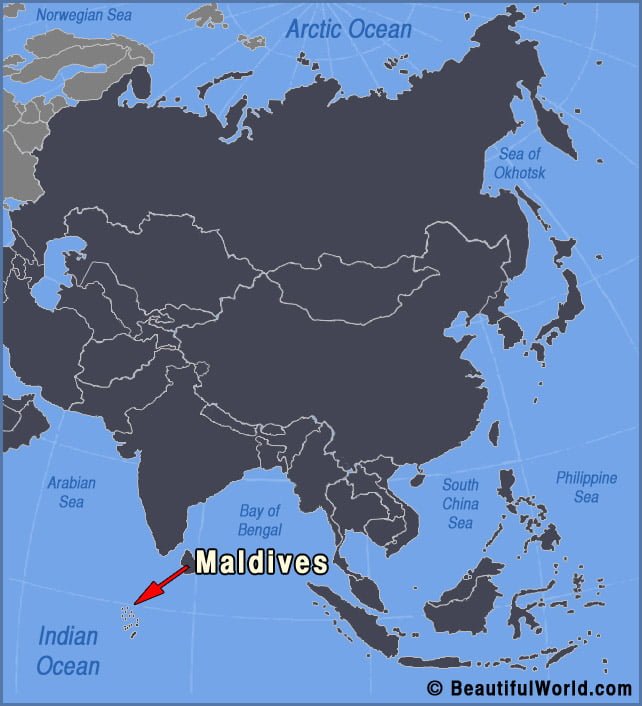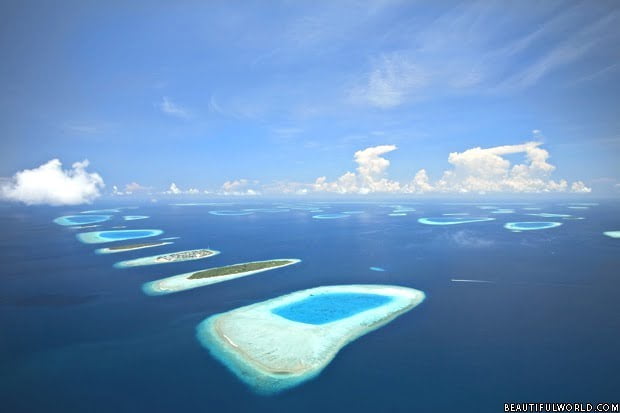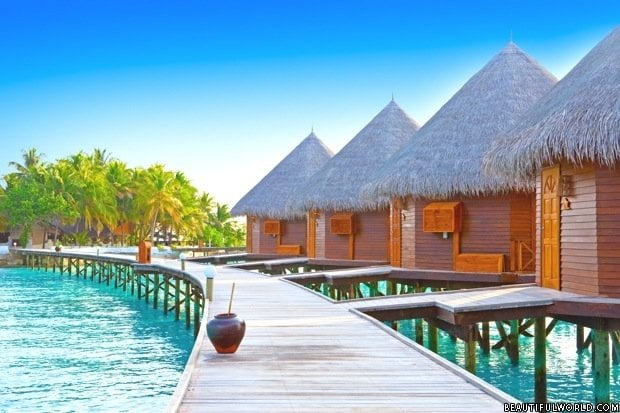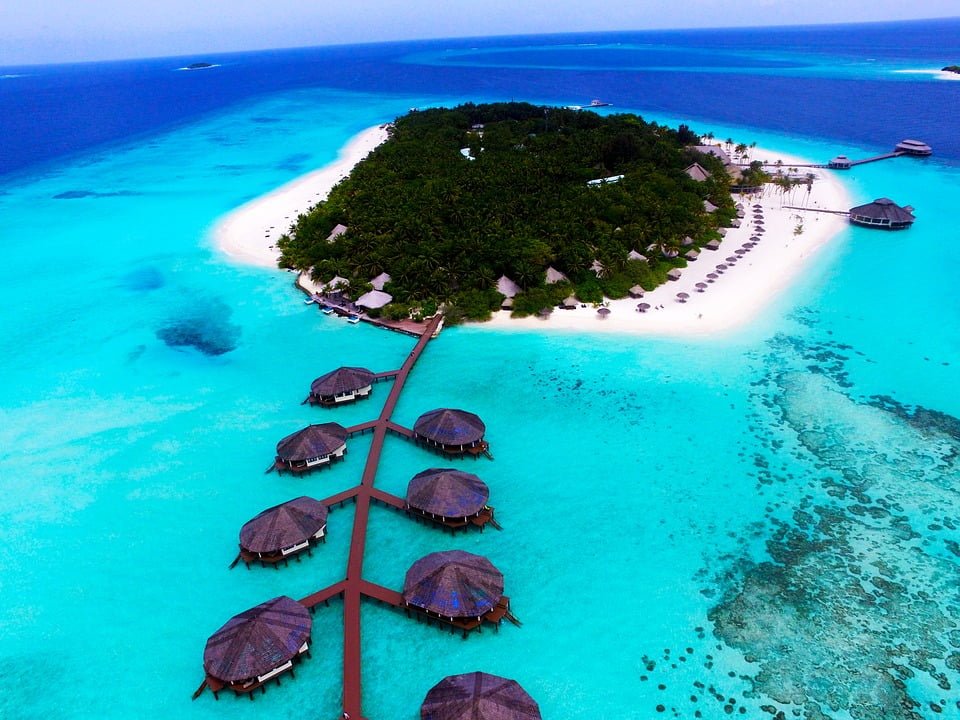This beautiful string of coral islands in the Indian Ocean must surely qualify as being an earthly paradise and most visitors to the Maldive islands enjoy a warm welcome and experience a true feeling of peace and tranquillity. These islands, however, are noted for their stormy past both physically and politically and even in recent years, there has been much unrest. From an environmental point of view, the future of the Maldives is even more uncertain and as the world’s lowest country, the threat of rising sea levels presents a very real possibility that these islands could become uninhabitable in the relatively near future and disappear completely within a short geological time-scale. So welcome to Beautiful World’s travel guide where you can learn all about the Maldives, what the Maldives are and where they are located.
Maldives Facts & Information
Time zone: Greenwich Mean Time +5 hours
Religion: Islam. It is illegal to openly practice any other form of religion.
International Dialling Code: +960
Currency: Maldivian Rufiyaa
Language: Maldivian, also known as Divehi. English is also widely understood and used especially in tourist regions.
Flag: The Maldivian flag is green with a red border and a central white crescent.
Where are the Maldives located?

The Maldives are a large group of islands located to the south-west of the southern tip of India. These are coral islands which have formed on the tops of a range of submerged mountains known as the Chagos-Maldives-Laccadive ridge which runs approximately in a north-south direction, straddling the equator. Covering an area of 298 sq km, this is the smallest country in southern Asia in respect of land area but is also the most widely dispersed country in the world consisting of 1,192 separate islands spread over a length of 820 km and a width of 130 km.
The Maldive Atolls

The whole of the Maldives forms part of a large archipelago of geologically linked islands but they are formed in characteristic shapes known as atolls. Atolls are frequently encountered in coral island groups and individual atolls often form a circular shape enclosing an area of sheltered water. The islands themselves also typically form a roughly circular shape with a central lagoon which may be completely or partially enclosed. In many cases several different islands may share the same lagoon and there are many other small islands which do not conform to this pattern.
The Maldives comprise of 26 individual atolls but, for administrative purposes, the Maldivian government has split the islands into 20 different named atolls each of which has an administrative code, usually a letter or two, which is useful when identifying a particular island as the same island names frequently appear throughout the Maldives. The administrative atolls and their identification codes are as follows:
Haa Alif Atoll (HA)
Haa Dhaalu Atoll (Hdh)
Shaviyani Atoll (Sh)
Noonu Atoll (N)
Raa Atoll (R)
Baa Atoll (B)
Lhaviyani Atoll (Lh)
Kaafu Atoll (K)
Alif Alif Atoll (AA)
Alif Dhaal (Adh)
Vaavu Atoll (V)
Meemu Atoll (M)
Faafu Atoll (F)
Dhaalu Atoll (D)
Thaa Atoll (Th)
Laamu Atoll (L)
Gaafu Alif Atoll (GA)
Gaafu Dhaalu Atoll (Gdh)
Gnaviyani Atoll (Gn)
Addu Atoll, previously known as Seenu Atoll, (Seenu)
What is the Correct Pronunciation for the Name Maldives?
There are some variations in the way that the name “Maldives” is pronounced. In the UK, the most common pronunciation is Moll-Deevs, rhyming with Doll Leaves, with the first syllable being most heavily stressed. Mall-Deeves, rhyming with Pal, is also used. In the US, a pronunciation of Moll-Dives rhyming with Doll Hives is the usual pronunciation with the stress usually, but not always, being placed on the second syllable.
What is the Origin of the Name Maldives?
There is some uncertainty regarding the origins of this country’s name. The word certainly comes from languages used by early inhabitants and Malayalam, Sanskrit, Sinhala and Tamil have all been suggested. It is generally accepted that “Dive”, with variations in spelling, means “island”. The Maldivian people are referred to as “Dhivehin” meaning islanders. There is also general agreement that “Mal” is translated as “garland”. The name Maldive therefore means “Garland Islands” and would seem to be completely appropriate when considering the garland-like shapes of the atolls. When the islands were under Dutch control, they were known as “Maldivische Eilanden” and the British merely anglicised the name firstly to “Maldive Islands” and subsequently to “Maldives”. Officially the name of the country is “The Republic of Maldives”.

How were the Maldives Formed?
The island archipelago of which the Maldives is part is the uppermost part of a submarine mountain range. It is likely that these peaks once stood high above the surface of the sea but, due to erosion, or tectonic movement, these land masses have now subsided below the surface. Conditions in this region are however ideal for coral growth in the warm shallow waters and the bony coral structures would cover the retreating rocks. Further geological movement, or a fall in sea levels, can cause an uplifting of the coral beds above the surface forming low-lying coral islands. The shape of the atolls has also been questioned and it has even been suggested that their circular shape could be
The shape of the atolls has also been questioned and it has even been suggested that their circular shape could be the result of corals growing around the uppermost parts of ancient super-volcanoes but this is most unlikely. In all probability, the shape of the atolls is likely to be simply due to the fact that the previous land masses would have been ringed by coral reefs and when the land disappeared, new coral would have grown over the foundation of the ancient corals. The shape of the atolls is therefore likely to follow the shape of the shoreline in an earlier era. Similarly shaped atolls are found in many other parts of the world.
History of the Maldives
The islands have been inhabited since ancient times but the absence of written language and the ephemeral nature of early island buildings means that nothing remains of the islands’ earliest culture. Studies of language and customs, however, would suggest that the early island settlers arrived from the Indian sub-continent, Sri Lanka in particular. These Sinhalese people are believed to have arrived around 500 BC bringing with them the Buddhist religion. Many features of Maldivian customs and language originate from this Buddhist period which lasted around 1500 years. Archaeological remains of Buddhist buildings can be found throughout the islands. A major change came about in the 12th century when the country’s leader, Dhovemi, converted to Islam and changed from being a Buddhist King to an Islamic Sultan.
Although fishing has always played a major part in Maldivian life, the country has also been known as a great trading nation. Even as early as the 10th century, there was major trade with other Asian and African countries and cowrie shells which are abundant throughout the islands were particularly prized as they were actually used as currency at this time in many countries so visitors to the islands could literally pick up money. Coir fibre, from the husks of coconuts was also highly desirable as its strength and non-rot properties made it an essential part of any sailing craft’s rigging. Dried tuna, ambergris and coco de mer nuts were other valuable trade commodities.

The influence of European countries began in the mid-16th century when the Portuguese established a trading post and garrison on the islands. Their attempt to impose Christianity on the resident population was met with a great deal of hostility and they were driven out fifteen years after their arrival. In the mid-17th century, the Dutch were a major force in the region and had taken control of Ceylon (Sri Lanka). They assumed authority over the Maldives but chose not to take any local involvement in government, preferring to let things continue more or less unchanged.1796 saw the Dutch ousted by the British, the islands becoming a British protectorate. This arrangement was ratified many years later in 1887 with the Sultan retaining his rule. In an attempt to form a constitutional monarchy, the British began taking power away from the Sultan and placing it in the hands of the Chief Minister. The country’s first constitution was produced in 1932 but met with a great deal of anger and resentment. The document was publicly torn up by protesters. In 1953, the First Republic was declared under the control of President Muhammed Amin Didi. Riots followed and Didi was beaten to death. In the 1950s, the British military presence in the islands was increased utilising the wartime airfield on the southerly Addu Atoll. This brought great financial benefits to the most southerly Maldive islands but the country’s political leaders disapproved. The three most southerly atolls declared independence from the rest of the Maldives but such a move was quashed when gun-boats were sent to reclaim the lands. The British base closed in 1976. The Maldives became a completely independent country in 1965 and a republic in 1968 finally consigning the Maldivian Sultanate to the history books.

Any hopes for political stability, however, were short-lived and in 1970 the Prime Minister was arrested and exiled and the President fled the country along with vast sums of money from the treasury. From 1978, President Gayoom took the reins and led the country for the next thirty years bringing some stability but his rule was highly criticised as being dictatorial. There were three coup attempts in 1980, 1983 and 1988, the latter requiring the intervention of the Indian armed forces. Towards the end of Gayoom’s term of office, some political reforms appeared leading to direct presidential elections and a new constitution in 2008. In 2011 the country’s President Nasheed was forced to resign and arrested on what are widely believed to be politically motivated charges. Elections in 2013 saw Nasheed winning the most votes in the first round but the government of the day had the result annulled. The new President, Yameen, followed a very anti-western agenda and there were many political arrests. He survived an assassination attempt in 2015. The Maldives joined the Commonwealth in 1982 but left in 2016 as a protest against allegations of corruption and human rights failings. Politics in the Maldives is anything but boring.
People of the Maldives
Unlike some island populations, the vast majority of the people living in the Maldives have their family roots firmly planted on the islands and are considered to be an indigenous population. They are known as Maldivians or Dhivehin (Islanders) and the most widely spoken language is Maldivian with some regional differences between the islands. The population of the Maldives is currently around 400,000.

Maldive Weather
The Maldives are located fairly centrally in the tropics straddling the equator and spanning the latitudes one degree south to eight degrees north of the equator. This special location of the Maldives means that temperatures vary little and are generally between 25 and 30 degrees Celsius. Despite their tropical location, the islands do still have some seasonal differences mainly due to the islands lying in the path of tropical monsoons. The appearance of the monsoons cannot always be accurately predicted but the least rain tends to fall during January, February and March with heavy downpours expected in May, November and December.
Maldive Airports
Most visitors to the Maldives will arrive at the Velana International Airport (Code MLE) which serves Malé the Maldivian capital. There are three other international airports serving different islands. These are: Gan International Airport (GAN), Hanimaadhoo International Airport (HAQ) and Villa International Airport (VAM). As is to be expected with such a widespread country, there are many domestic airports as follows: Dharavandhoo Airport (DRV), Fuvahmulah Airport (FVM), Ifuru Airport (IFU), Kaadedhdhoo Airport (KDM), Kadhdhoo Airport (KDO), Kooddoo Airport (GKK), Dhaalu Airport (DDD) and Thimarafushi Airport (THF).

The use of seaplanes means that all parts of the Maldives are accessible by air and such transport is popular with tourists although more expensive than boat travel. It is worth remembering that visitors arriving at the main Velana International Airport, also known as Malé International Airport (Maldives) as it serves the capital city of Malé, will need to transfer to their destination. The various resorts in the Maldives invariably arrange for the necessary transport, often by speedboat but these transfers can be expensive and there is no simple way of avoiding these costs so they must be budgeted for. Those visiting Malé city can simply use the regular ferry service. This airport has a single runway and is located on Hulhule Island in North Male Atoll just to the north-east of Malé.
Visiting the Maldives
Tourism in the Maldives commenced in the 1970s and now forms the major part of the islands’ economy. The islands are small, in some cases very small and some tiny islands have been developed specifically for tourists. The country has a policy of welcoming all and no visas are required. Anyone with a valid passport, sufficient funds and proof of onward travel, i.e. a booked return flight, may visit the islands. This open-door policy has resulted in some people suggesting that this is an ideal place to escape to, not only for those looking for a peaceful holiday but also for fugitives from justice. This is most certainly not the case. Foreigners have no rights of permanent residence and UK citizens attempting to hide from justice should be aware that there are extradition agreements between the UK and the Maldives. Currently, there are no such agreements with the USA.

The sea and the white beaches are probably the main attractions and the Maldives certainly have some of the best beaches in the world with turquoise lagoons teeming with underwater life. Water sports are very popular and the beaches are incredible during the day but during the hours of darkness they sometimes take on an almost magical appearance with a dancing blue glow. As the waters are disturbed by small waves on the beach or when ripples are caused with a hand or foot, flashes of blue light occur producing the most romantic background lighting on earth. This phenomenon is usually due to the presence of bioluminescent phytoplankton in the warm waters of the Indian Ocean and the blue flashes form part of these creatures’ defence mechanism. There is a suggestion that where the blue colouration is more stable and long lasting, ostracod crustaceans may be involved. The glowing beach phenomenon can be frequently observed throughout the islands but catching sight of it really requires being in the right place at the right time and a good deal of luck.
All-Inclusive Resorts in the Maldives
Probably no other country in the world caters for tourists as well as the Maldives and the “all-inclusive” resorts are a firm favourite. Traditional island properties including those on stilts above lagoons often offer amazing views and sense of tranquillity. These holiday deals really take the worry out of paying for all of those holiday extras as everything is included in the price. Airport transfers, however, may result in unforeseen and unavoidable costs so it is well to check this with the operator. If you are happy to not have an all-inclusive package there are more affordable hotel accommodation options in regular hotels in the Maldives.

Threats Facing the Maldives
As a country with an average height of just 1.5 m above sea level and a high point reaching the dizzy altitude of just 2.4 m, the sea is an ever-present threat. The 2004 Indian Ocean earthquake and tsunami caused severe damage to the Maldives and six islands were totally destroyed. Almost every island was damaged and over a hundred lives were lost. This was undeniably a major catastrophe but, given the low-lying nature of the islands, some have questioned why the tsunami damage was not even more severe. The main reason why the whole of the island group was not completely obliterated is almost certainly because the tidal wave did not reach the great heights attained elsewhere. Such waves rise in height as they reach shallow waters such as a continental shelf but, despite the flat appearance of these islands, the land falls away steeply to the depths of the Indian Ocean.

All areas of coral are permanently threatened as they require very specific requirements in order to survive. Any rise in seawater temperatures can result in the death of corals. In 1998, an El Nino incident caused such a temperature rise resulting in coral bleaching of two thirds of the islands coral but this largely recovered in following years. In 2016, an even worse incident occurred with water temperatures reaching an all-time high of 31 degrees Celsius. This time almost 95% of the coral was lost. With world sea temperatures steadily rising, such incidents are likely to become more frequent in the future and the prospect of coral bleaching occurring in consecutive years could result in the complete destruction of the islands’ delicate ecosystems. In addition to rising sea temperatures, rising sea levels also poses a very real threat to the long-term survival of the islands. Current predictions are that sea levels will rise by around 59 cm by the year 2100 which would render most of the islands uninhabitable. Some predictions are even gloomier suggesting that in as little as 30 or 40 years, life on the islands could become untenable. There are however some contradictory findings and, despite the significant rises in sea levels worldwide, measurements at the islands have recorded rises of just 1.7 to 1.8 mm per annum. In truth, no one is able to accurately predict when, or if, the Maldives will disappear.

The Maldives, despite the islands’ scattered nature, have a strong sense of national identity and religious unity. The rest of the world are welcome to visit but the Maldives retain their full independence and are solely for the Maldivians. Political unrest, natural disasters and an uncertain future make this island nation amongst the most precarious in the world but the natural beauty of these garlands of islands set like precious stone in a sea of turquoise continue to attract visitors from around the globe.
The Maldives: A remote fragile paradise but so, so beautiful.


So pretty Maldives hope one day I can visit.
you can contact me on Facebook and Instagram hanifinderyas for any information i will join you there I want to visit also 🙂
i am planing to come there on 19th november 2020
I’ve seen the water glow in Florida. It’s rare but it was the most spectacular sight and experience. I so want to go to the Maldives.